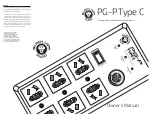
29
device again using an S-video or Composite Video connection as this
makes an unnecessary second connection of poorer picture quality.
You need only connect using a composite Video connection if neither
Component Video nor S-video is supplied on the video source device
(for example, with some analog video cameras). If S-video connectivity
is available, you should use it in preference to composite Video.
See "Connecting Video source devices" on Page 22 for details.
To
To
To
To connect
connect
connect
connect the
the
the
the projector
projector
projector
projector to
to
to
to an
an
an
an S-video
S-video
S-video
S-video or
or
or
or a
a
a
a Composite
Composite
Composite
Composite Video
Video
Video
Video
source
source
source
source device:
device:
device:
device:
With an S-video cable:
With a Video cable:
1.Take an S-Video cable and
connect one end to the
S-Video output socket of the
Video source device.
2.Connect the other end of the
S-Video cable to the S-VIDEO
socket on the projector.
1.Take a Video cable and
connect one end to the Video
output socket of the Video
source device.
2.Connect the other end of the
Video cable to the VIDEO
socket on the projector.
3.You should also connect the separate audio cable to a suitable
audio amplifier.
The final connection path should be like that shown in the following
diagram:
Summary of Contents for PRJ3D99TU
Page 50: ...50 ...
















































